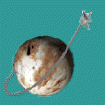
Current Issues:
SpaceViews
SpaceViews Update
Breaking News
Back Issues
Search
Subscriptions
Submissions
Forum
Space Sites of the Week
Home
Mars Pathfinder
Comet Hale-Bopp
Top Ten Stories of '96
Life on Mars?
Pathfinder Mission Declared a "100 Percent Success"
After one month on the Martian surface, the Mars Pathfinder mission reached the end of its primary mission as mission manager Richard Cook declared the mission a "100 percent success" while making plans for continued science from the lander and rover.
![[image of Sojourner on Mars]](../970815/images2/sojourner.jpg) JPL officials and scientists reported on the success of the mission at an August 8 press conference, a few days after Pathfinder completed 30 days on the surface, the end of the "primary mission" for the spacecraft, as defined by the mission plan.
JPL officials and scientists reported on the success of the mission at an August 8 press conference, a few days after Pathfinder completed 30 days on the surface, the end of the "primary mission" for the spacecraft, as defined by the mission plan.
The program moves into an "extended mission" which will last until the rover and lander eventually fail, which may be months to a year in the future. "We have got a healthy spacecraft, a healthy rover and healthy instruments," said project scientist Matthew Golombek.
After taking a two-day "holiday" early this month to recharge its batteries, the rover and lander continued daytime operations. Nighttime work will be limited to keep battery use down.
During the primary mission the rover and lander took 9,000 images, several million atmospheric and weather measurements, and 9 geological analyses of rocks and soil, exceeding expectations of mission planners.
During the extended mission, scientists plan to gather more data to better understand the conditions in the Ares Vallis landing site, particularly as Martian summer ends there and dust storms develop.
The most ambitious long-term plans have been reserved for the rover Sojourner. It will spend the next several weeks exploring an area near the lander dubbed the Rock Garden, taking data on the composition of the rocks and soil in that region.
The rover may also return to the lander and study the composition of soil samples collected by magnets attached to the rover. The magnets were part of another experiment to study the magnetic properties of Martian dust, and initial findings indicated that the dust was much more magnetic than expected.
Long-term plans for the rover call for it to travel about 100 meters to the crest of a small hill, studying several large boulders along the way. The journey would take more than a month at the rover's slow rate of travel and would push the small explorer to its limits.
"But once we get to the top, we'll be able to see a whole new vista of Mars we have never seen before, and from an angle looking down, not up," said project scientist Matthew Golombek. The lander is in the bottom of a small depression.
The rover did get "stuck" last week when its wheels got caught on two different rocks. The rover automatically stopped moving and remained in place until the weekend, when controllers sent instructions to back the rover off the rocks.
The Pathfinder Web site has also been a tremendous success, Golombek reported. In the first month after landing the Pathfinder site garnered 565 million hits, including 47 million on July 8 alone. Golombek called it "the biggest Internet event ever."
